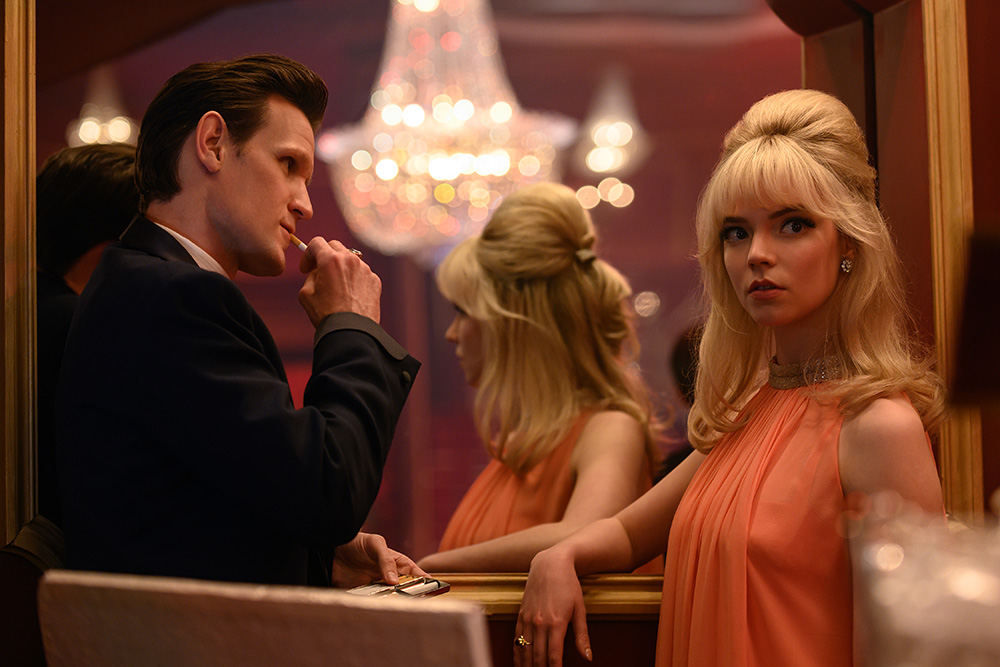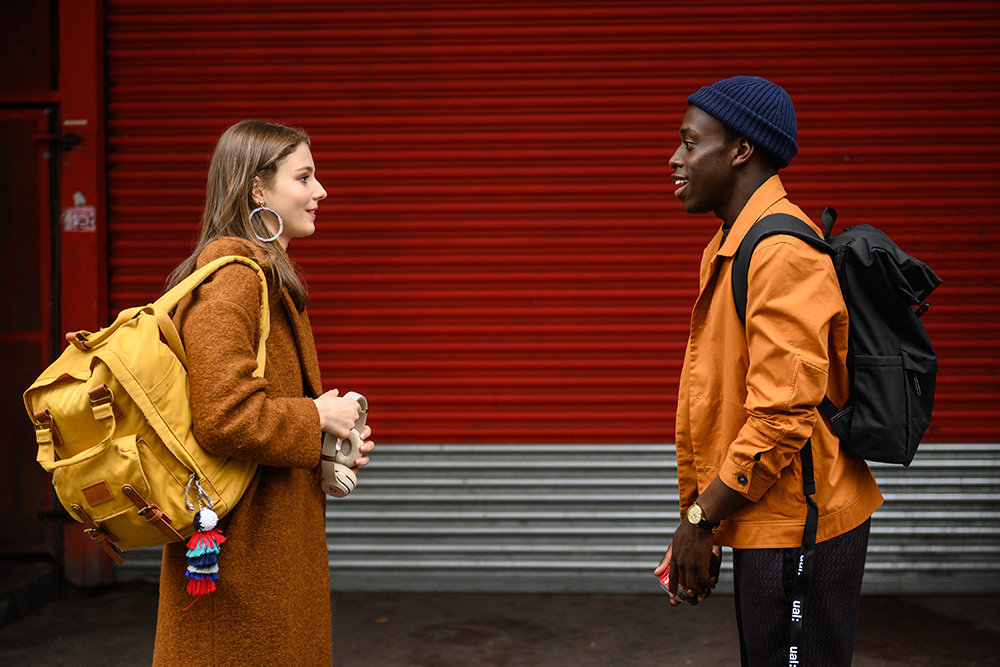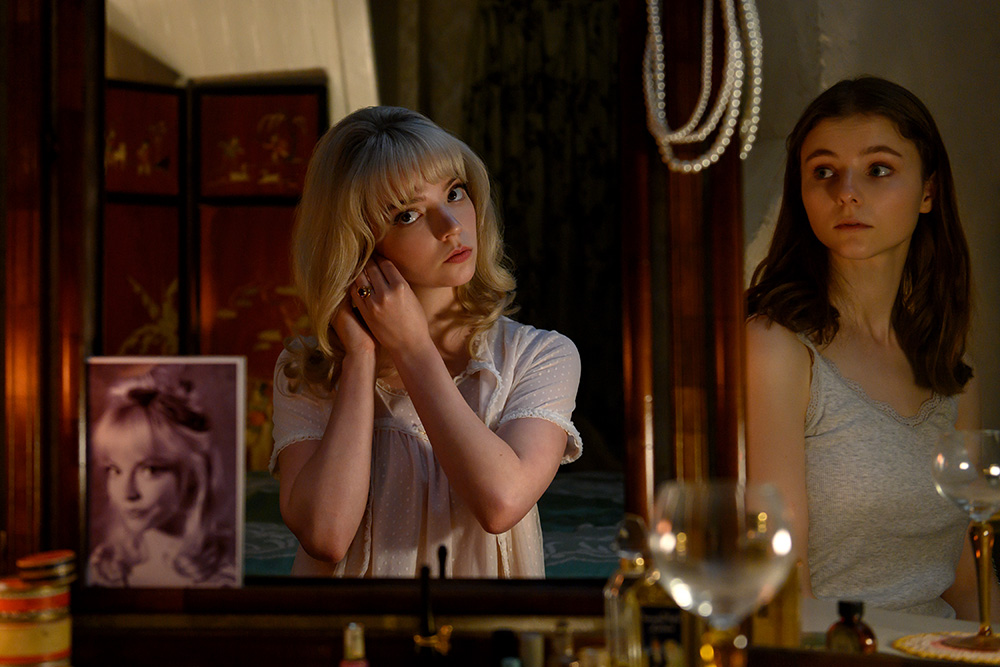What’s the most?
Eloise (Thomasin McKenzie) sees dead people. Or, maybe, she’s crazy. No. She definitely sees dead people. Director Edgar Wright and co-writer Krysty Wilson-Cairns aren’t interested in making Last Night in Soho a commentary on mental illness when they can merely use mental illness as a plot device (Eloise’s mother committed suicide a decade previously after her own journey to London proved too much to bear). That sounds snarkier than it is. Yes, they could have handled the topic better, but I say it simply because it’s true. While others watching this freshman from the sticks get haunted by nightmarish visions of ghosts believe her insane, the filmmakers make certain we know what she sees is real. To her at least. Its historical veracity is somewhat in the air.
Less confusing than convoluted, this is the world we enter at the start. Eloise has been accepted to a prestigious fashion school in the big city and can’t wait to enjoy the bright lights and excitement her nostalgia for 1960s aesthetic (via clothes and music) has propped up as the best era in her mind. We know what her grandmother knows, though. London is neither a perfect place now nor was it better then. That was a time of true horror for many young women seeking a path towards fame and fortune—one that tragically consumed a wannabe starlet named Sandie (Anya Taylor-Joy). Don’t worry. Eloise will catch on quickly. How can’t she when the first stranger she meets (a cab driver) inappropriately flirts with her upon arrival?
Between his creeper, the yet unknown John (Michael Ajao) offering to help carry her bags upstairs, and a duplicitous opportunist in roommate Jocasta (Synnove Karlsen), London is nothing like Eloise had hoped. But things can change quickly in a new place. A fallen advertisement for a flat not far from campus can provide a reprieve from the catty classmates in student housing. The landlady (Diana Rigg‘s Ms. Collins) runs a tight ship, but there are some intangibles waiting in her room at night. Sleep transports Eloise beyond just seeing ghosts in reflections. It sends her into the past itself to witness a kindred spirit in Sandie. She too lived in this room with dreams of success and this first journey in her shoes even hints at its possibility.

As anyone who’s seen the trailer knows, that possibility is short-lived. The man who appears positioned and motivated to help her (Matt Smith‘s Jack) soon becomes a violent aggressor who kills Sandie in cold blood. Eloise obviously can’t prevent the crime considering it already happened, but maybe she can achieve justice in the here and now if her suspicions about a silver-haired man (Terence Stamp) being Jack are true. But the attempt won’t be easy. Just because she sees Sandie and Jack’s tumultuous saga in her dreams doesn’t mean she has suddenly stopped seeing dead people when awake. Rather than glimpses of her mother in the mirror, these ghosts are maliciously drawn as men without faces scaring her in public and causing the world to question her sanity.
It’s an intriguing conceit that really works for the first two-thirds of the runtime. The more Eloise watches in her dreams, the more she understands the fate of so many women at a moment in time she used to worship as paradise. The farther along she gets, the greater the weight of that truth becomes upon her shoulders. Her big first-year project is recreating the dress Sandie wore that first night. Her teacher loves it. Jocasta is jealous. And it’s everything Eloise wants as far as reliving the magic of this stranger’s untapped potential (she changes her hair to match Sandie’s and buys a vintage coat too). Experiencing the exploitation, prostitution, and violence, however, places all of it under a dark shadow she’s unsure she can fully escape.
Eloise fears finishing the story and thus fears Ms. Collins’ flat. That’s when the monsters leave the confines of her room to find her wherever she is outside it. They ruin a date with John, cause her to flake on work as a bartender, and even get her ripping her project to pieces in front of the class. Sandie’s demise isn’t something she can ignore. Eloise must confront it and the city for the nightmarish evil it contains no matter what anyone says. Every time someone explains she’s in a part of town that “used to be bad ” unfortunately guarantees she’s about to experience just how bad courtesy of Sandie and her sixth sense. It gets intense as Wright goes full horror with escalating set-pieces.

The direction is impeccable as always. How Wright merges McKenzie and Taylor-Joy as reflections of each other in a single scene is breathtaking because it’s not simply a matter of putting one behind glass. He’s using multiple panes along curves that force the reflection to be three-fold and the effect never misses a beat. A scene with Smith dancing with them also simultaneously has one twirling off-screen as the other comes on with invigorating flair. Add the darkened visages of nameless sexual abusers haunting Eloise on the streets to the point where we’re wincing in preparation for what she’s going to do with the scissors in her hand and Last Night in Soho proves a visual treat of genre style augmented by another flawless Wright-picked soundtrack.
And then comes the conclusion. While I don’t have anything against the direction Wright and Wilson-Cairns go as far as their so-called “twist” (it’s hardly that), it’s not without disappointment considering it doesn’t really work. Why? Because it tries to play both sides despite making things very clear that Eloise sees dead people. You can’t tell us she does, prove her premonitions exist in history, and then change crucial details without calling her “gift” into question. Doing so allows for the “twist,” but it also cuts the conceit down at the knees. Not only that, but it unavoidably forces us to think about empathizing with the toxic rapist specters terrorizing poor Eloise throughout. It thankfully makes the conscious decision not to pity them, but why go there at all?
It’s a head-scratcher that swings for the fences where female empowerment is concerned, but whiffs on the attempt. The effects during a staircase confrontation sequence are also so much shoddier than everything that came before it with revelations that prove more convenient than profound. McKenzie, Ajao, Stamp, and Rigg are great along with top-notch production value and direction, but they’re left out to dry by a climax that can never quite find its footing. It by no means ruins the experience completely, though. I do think there’s a lot here that’s worthwhile, but keep your expectations tempered. Because while Wright surprisingly goes for the jugular during act two, his sunnier disposition eventually takes over. While that’s great with comedies, however, it renders this one a bit toothless.
photography:
[1] Anya Taylor-Joy stars as Sandie and Thomasin McKenzie as Eloise in Edgar Wright’s LAST NIGHT IN SOHO, a Focus Features release. Credit: Parisa Taghizadeh / © 2021 Focus Features, LLC
[2] Matt Smith stars as Jack in Edgar Wright’s LAST NIGHT IN SOHO, a Focus Features release. Credit: Parisa Taghizadeh / © 2021 Focus Features, LLC
[3] Thomasin McKenzie stars as Eloise and Michael Ajao as John in Edgar Wright’s LAST NIGHT IN SOHO, a Focus Features release. Credit: Parisa Taghizadeh / © 2021 Focus Features, LLC

